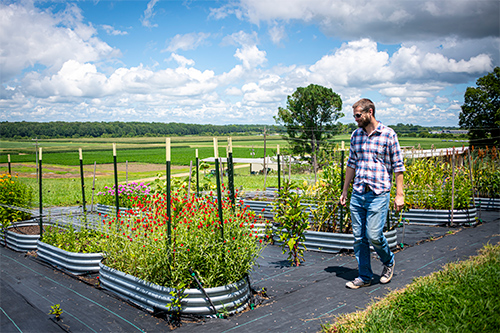Contact: Lily Grado
STARKVILLE, Miss.—Overlooking the flourishing fields of the R.R. Foil Plant Science Research Center, also known as North Farm, rests a small, blooming oasis. Not only is Mississippi State’s cut flower garden home to more than two dozen varieties of specialty-cut annual flowers, it also serves as the perfect setting to encourage growth in student learning.
For Cole Etheredge, associate professor in floriculture and ornamental horticulture in MSU’s Department of Plant and Soil Sciences, installing and overseeing the 24 raised flower beds allows his students to learn how to properly care for and harvest cut flowers. Developing this useful skill could eventually help the students qualify for jobs in areas such as floral design, cut flower production and horticulture.
“As we continue to expand the flower garden, I plan to incorporate as many floral-based courses as possible, including Floral Design II in the fall and a cut flower gardening class in summer 2025,” said Etheredge. “My overall goal is to give the students the knowledge and confidence needed to produce a portion of their own cut flowers for future careers.”
Funded by the American Floral Endowment, the garden was planted in summer 2022, and has blossomed into a flourishing experiential classroom. The flower beds are equipped with irrigation systems, weed barriers and compost bins.

Etheredge has grown and evaluated 23 varieties of specialty-cut annual flowers as part of an experiment through the Association of Specialty Cut Flower Growers.
“We start the seeds in greenhouses at the beginning of March and then plant them in the garden in mid-April,” Etheredge said.
For Lynette McDougald, manager of the University Florist and instructor in the floral management program, the garden allows students to use locally grown, cut flowers in projects such as centerpieces for parties, church decorations or everyday design.
“The beds grow atop a hill overlooking the farm which I believe is one of the prettiest places on campus,” McDougald said. “This project is especially important since many of the varieties we’re growing are often found on the U.S. West Coast for national distribution. They do not ship well, so it’s important that we grow them for local use.”
The garden is home to a variety of flowers, including ornamental sorghum, solaria, sunflowers and gomphrena. The faculty hopes to eventually expand the garden with more varieties and additional beds.
Having the opportunity to introduce the students to the process of setting down beds, planting seeds, measuring and applying fertilizer, and then cutting, harvesting and learning how to handle post-cut flowers are skills that Etheredge hopes his students will excel in once they finish their MSU courses.
“By allowing students to grow and manage cut flowers, they gain a better understanding of what it takes to produce cut flowers for use in jobs that utilize floral design,” he said.
This season’s flowers are being harvested by the Floral Design II class, with students using them to create aesthetically pleasing floral designs.
For more information on MSU’s Department of Plant and Soil Sciences in the College of Agricultural and Life Sciences, visit www.pss.msstate.edu.
MSU is taking care of what matters. Learn more at www.msstate.edu.